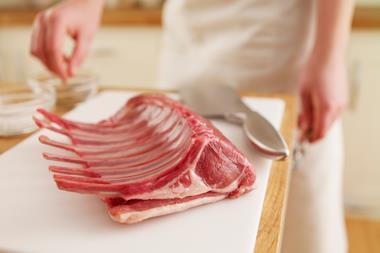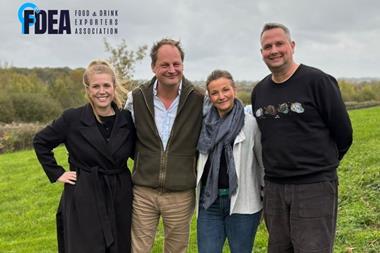analysis by Peter Crosskey
It used to be the jewel in the crown of the British bacon industry, and its boss Max Hilliard is regarded as a young manager of outstanding talent. But even Hilliard has found himself swamped by the crisis facing the British pig industry.
Malton Foods has chalked up first half losses of £5.4m and given a battering to its parent Uniq, it was revealed last week (The Grocer, November 18, p13).
The reason given is the disparity between UK and continental pig prices, with the strength of sterling at the heart of the problem.
The daily conversion of CAP support from euros into sterling has also helped to keep all British farmers at a disadvantage to their European competitors.
Uniq chairman Sir Ross Buckland pointed to the likely sale of Malton, or some sort of partnership arrangement, by next year.
He stressed: "UK pig prices are now at an unsustainable 25% premium to continental prices."
It adds up to a competitive pricing scenario for retailers, but the harshest of times for suppliers and processors. A recent victim was Stockport independent curer E Simpson, which went into receivership at the end of October.
The firm was the last of the British independent curers, with nearly a century of trading behind it.
As National Pig Association chairman Stuart Houston says: "British pigs may appear expensive to Sir Ross Buckland, but they're not earning British farmers any money."
If pig producers can earn around £1/kg deadweight, they are likely to see a profit. But most will have debt charges in the order of 4-5p/kg to pay off over the coming years.
To survive, a processor like Malton must now turn to bringing in more foreign pigmeat. Malton itself is to bring the percentage of imported animals up from 40% to 50%.
It is an ironic scenario in the context of strenuous efforts by the National Farmers' Union with its British Farm Standard mark initiative and the Meat and Livestock Commission with the British Meat Quality Standard Mark to urge the British public to eat more British sourced product.
The problem is compounded by declining raw material availability. "We were extremely disappointed to see the closure of Malton's Middlesbrough plant," says Houston. "But three years ago we did predict that UK pig numbers would fall."
And to make the situation even worse, swine fever came along this year. East Anglian farmers have seen the scourge wreaking havoc since August.
While the initial outbreaks were under control by September, the movement bans and veterinary precautions will affect clean pig supplies for a while yet.
The epidemic has cost the producers the sale of an estimated 300,000 slaughter pigs in East Anglia.
With adverse conditions prevailing, it was perhaps not surprising that the Meat and Livestock Commission should turn to shock tactics to urge people to eat more British product. Its series of advertisements this year claiming British welfare was superior to foreign practice one ad showing a sow suckling her litter carried the strapline After she's fed them she could be fed to them' caused outrage abroad and disquiet in many domestic quarters. Many including The Grocer itself thought the advertising style could deter people from eating bacon and pigmeat altogether. Minister of agriculture Nick Brown and MLC chairman Don Curry have, nevertheless, continued to stand by the advertisements.
Danish Bacon and Meat Council marketing director John Howard, however, lodged a complaint with the Advertising Standards Authority a ruling is imminent as The Grocer went to the press.
Meanwhile, demand for British bacon is not rocketing as a result. Bacon remains a flat market, unlikely to grow in volume for the foreseeable future, if at all. Taylor Nelson Sofres reports a 2% decline in average purchase weights in June this year, coupled with a 4% drop in the household penetration of rasher bacon [year on year].
This is despite two years of heavy volume discounting by slicers and retailers, which has not generated new users for the category.
People will always buy quite a lot of bacon. Dutch Meat Board UK md Robert Smith observes: "You could say the British love their bacon. Its acceptance is so universal that it has very few negative consumer perceptions."
But when you have undifferentiated product on dull fixtures, you are only going to ensure the persistence of a public mindset that keeps the use of bacon within certain all too well established parameters butties and breakfast.
There is growing acceptance that added value is the way forward. Bacon needs to follow the convenience route with style and flair in the manner many other major sectors have done. However any such offerings will need a substantial critical mass to succeed in the mainstream market.
John Howard says: "The aims of any player in the UK bacon market must be to maintain core consumption and develop premium products to curb the commoditisation of the category.
"Above all, we need to extend opportunities for using bacon.
"While consumers' repertoires focus on bacon sandwiches and cooked breakfasts, they will miss other possiblities to use a product that we know they are already passionate about and enjoy eating."
For Howard, traditional lines such as bacon rashers for breakfast need to be reviewed to make packaging and preparation more convenient.
But they need to be accompanied by a range of new product ideas that will encourage consumers to try a fresh approach to bacon for snacks and light meals.
While bacon is regarded as a typically traditional product, it can also be used in some very modern ways, if imaginative product development is brought into play.
Smith accepts consumers tend to be fairly conservative in how they think of serving bacon even though many acknowledge that bacon is versatile.
"About 80% of the UK population eat it at least once a year, 40% once a week," he points out. "You are unlikely to recruit many more new users from the remaining 20%, but if you could extend the consumer repertoire, your existing users would probably buy more bacon.
"No-one has really paid a lot of attention to the bacon category and, as a result, the category has always tended to be supply-led, driven by events in the pig industry."
Smith is particularly critical of the fixtures' plethora of barely differentiated products.
The shopper's focus is not automatically on where bacon comes from but when and how it is going to be eaten, he stresses.
"What's the point in promoting bacon as a great breakfast product if the consumer only has five minutes to eat breakfast in the morning and get out of the house?"
Lunchtime is a bit less fraught: but eating lunch gets no more than five to 10 minutes, according to Smith.
"In the evenings, though, consumers might spend as long as 20 minutes in a kitchen and this is where the category can gain from a more extended repertoire."
Our continental neighbours can give us a fresh view of bacon with intelligent store placement, packing and presentation, and npd. A visit to a newly-opened provincial west coast French hypermarket, Intermarché's 3,000 sq m store at St Jean d'Angely in Charente (17) yielded some interesting finds in a 20m charcuterie fixture.
Bacon products here are merchandised in separate locations, both as an aid for roasting and as a light meal centre. The intended uses are explained on the packs.
Treating bacon like any other charcuterie line is an eye opener for the English, opening the category to a new identity.
Nor do rashers have to be long and thin. Take Herta or Roche des Vents round rashers. They are made of trimmed tenderloin which normally forms the eye of a back rasher.
Often eaten raw, the thinly sliced rounds offer shoppers portion control, convenience and added value.
But in this instance, the added value was not dear. The Herta line was 15 rashers of smoked tenderloin, 150g was on sale for FF16,10; Roche des Vents, eight slices weighing 100g, on shelf for FF13.50.
Further down the aisle were light meal centres such as sliced ham. This July, Limoge-based ham maker Madrange launched jambon à griller (ham to fry or grill). The new product has captured the French consumer's imagination.
It is a good example of an area in which there is a potential crossover in meal centres between bacon and other sectors, such as ham.
The cure is light and the product is easy to prepare. Two slices (with a 4% fat content declaration) weighing 160g were retailing for FF18.75.
Stuart Houston is disappointed that there is uneven use of pig carcases by British processors. "You go to these French supermarkets and they have a tremendous range of pork products, so it can't be beyond our guys to develop something similar."
While forend products have been developed by MLC in previous years, these have needed constant promotion to maintain consumer interest and sales.
{{FOCUS SPECIALS }}
Close menu
- Home
- Retail & Wholesale
-
Products & Suppliers
- Back to parent navigation item
- Products & Suppliers
-
Product Categories:
- Back to parent navigation item
- Product Categories:
- Alcoholic drinks
- Bakery
- Cereals & breakfast
- Cheese
- Chicken & poultry
- Chocolate
- Confectionery
- Crisps, nuts & snacks
- Dairy
- Fish
- Fresh produce
- Frozen
- Household
- Meat
- Own Label
- Sauces & condiments
- Seasonal
- Soft drinks
- Vaping
- Vegan & plant-based
- World foods
- Suppliers
- People
- Reports & Data
-
Topics A-Z
- Back to parent navigation item
- Topics A-Z
-
Popular topics:
- Back to parent navigation item
- Popular topics:
- Cost of living crisis
- Crime
- Deposit Return Schemes
- Finance
- Government & Regulation
- Health
- Inflation
- Loyalty
- Marketing
- Mergers & Acquisitions
- New Product Development
- Sourcing
- Supply chain
- Sustainability & environment
- Technology
- Ultra Processed Foods
- Vaping
- A-Z all topics
- Content by type:
- Events
- Ask iA (beta)
- Subscribe now
Sign in to comment on this article
Not logged in before? Register for FREE guest access today.
You will be able to:
- Read more stories
- Receive daily newsletters
- Comment on stories
Advert

















No comments yet